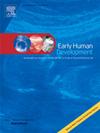作为早期神经发育替代物的心脏自主神经调节:系统回顾
IF 2.2
3区 医学
Q2 OBSTETRICS & GYNECOLOGY
引用次数: 0
摘要
背景:心脏自主神经调节与早期神经发育息息相关,但研究主要集中在特定领域,如注意力和记忆力,而忽视了广泛的神经发育结果。使用不同的研究人群和方法进一步阻碍了解释工作,这凸显了在这一领域开展更加一致的综合性研究的必要性。因此,本研究旨在通过系统性文献综述,阐明心脏自主神经调节(通过心率指数量化)与婴儿期整体神经发育的关系:在 Scopus、PubMed、Web of Science 和 ProQuest 数据库中对 1980 年 1 月至 2022 年 12 月间发表的研究进行了系统的文献检索。检索词由包含三个类别要素的词语组合而成:1)心脏迷走神经调节;2)神经发育指标;3)人群(新生儿/婴儿):结果:共纳入五项研究,涉及 933 名婴儿(其中 48% 为女婴),基线评估时间为出生至 26 周。研究结果喜忧参半:一些研究发现副交感神经活动与神经发育结果之间存在正相关,而另一些研究则报告了不显著或不一致的相关性。研究设计、测量方法和人群特征的差异很可能是造成这些差异的原因。然而,呼吸窦性心律失常(RSA)是最常用的指标,报告神经发育与自主功能之间存在显著关联的研究比例最高(RSA = 83 %,心率变异性 = 69 %),尤其是在控制年龄和出生体重等因素的情况下:尽管生命最初几年的自主调节似乎与神经发育有关,但所有心率指数或发育领域的证据并不完全一致。为了更好地理解这些关系,尤其是考虑到方法上的差异和潜在的混杂因素,还需要进一步的研究。认识自律神经系统调节的个体差异可以为了解神经发育轨迹提供有价值的见解。本文章由计算机程序翻译,如有差异,请以英文原文为准。
Cardiac autonomic regulation as a proxy of early neurodevelopment: A systematic review
Background
Cardiac autonomic regulation and early neurodevelopment are linked, but research has focused largely on specific domains, such as attention and memory, neglecting broad neurodevelopmental outcomes. The use of diverse study populations and methodologies further hinders interpretation, highlighting the need for more consistent, integrative research in this area. Therefore, the aim of this study was to clarify how cardiac autonomic regulation (as quantified by heart rate indices) is associated with global neurodevelopment in infancy through a systematic literature review.
Method
A systematic literature search was carried out in the Scopus, PubMed, Web of Science, and ProQuest databases for studies published between January 1980 and December 2022. The search terms were a combination of words that included elements from three categories: 1) cardiac vagal regulation, 2) neurodevelopment indicators, and 3) population (neonate/infant).
Results
Five studies involving 933 infants (48 % of whom were girls) and baseline evaluations from birth to 26 weeks of age were included. The findings were mixed: while some studies identified positive associations between parasympathetic activity and neurodevelopmental outcomes, others reported nonsignificant or inconsistent associations. The variability in study designs, measurement methods, and population characteristics likely contributed to these discrepancies. However, respiratory sinus arrhythmia (RSA) was the most commonly used indicator, and the highest percentage of studies reported significant associations between neurodevelopment and autonomous functioning (RSA = 83 %, heart rate variability = 69 %), particularly when controlling for factors such as age and birthweight.
Conclusions
Although autonomic regulation during the first years of life appears to be associated with neurodevelopment, the evidence is not entirely consistent across all heart rate indices or developmental domains. Further research is needed to better understand these relationships, particularly in light of the methodological differences and potential confounding factors. Recognizing individual differences in autonomic nervous system regulation could provide valuable insights into neurodevelopmental trajectories.
求助全文
通过发布文献求助,成功后即可免费获取论文全文。
去求助
来源期刊

Early human development
医学-妇产科学
CiteScore
4.40
自引率
4.00%
发文量
100
审稿时长
46 days
期刊介绍:
Established as an authoritative, highly cited voice on early human development, Early Human Development provides a unique opportunity for researchers and clinicians to bridge the communication gap between disciplines. Creating a forum for the productive exchange of ideas concerning early human growth and development, the journal publishes original research and clinical papers with particular emphasis on the continuum between fetal life and the perinatal period; aspects of postnatal growth influenced by early events; and the safeguarding of the quality of human survival.
The first comprehensive and interdisciplinary journal in this area of growing importance, Early Human Development offers pertinent contributions to the following subject areas:
Fetology; perinatology; pediatrics; growth and development; obstetrics; reproduction and fertility; epidemiology; behavioural sciences; nutrition and metabolism; teratology; neurology; brain biology; developmental psychology and screening.
 求助内容:
求助内容: 应助结果提醒方式:
应助结果提醒方式:


